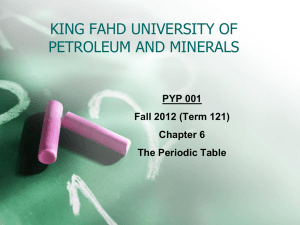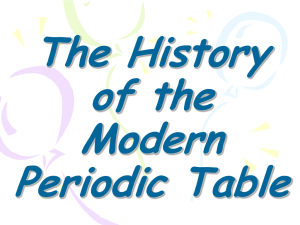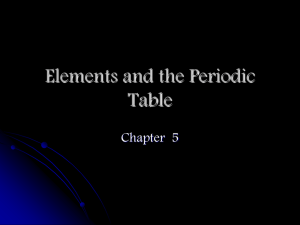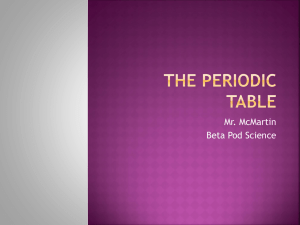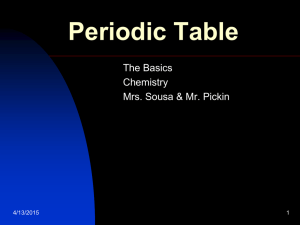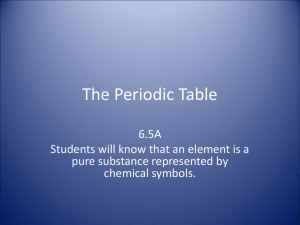Chapter 5 Notes – The Periodic Table
advertisement
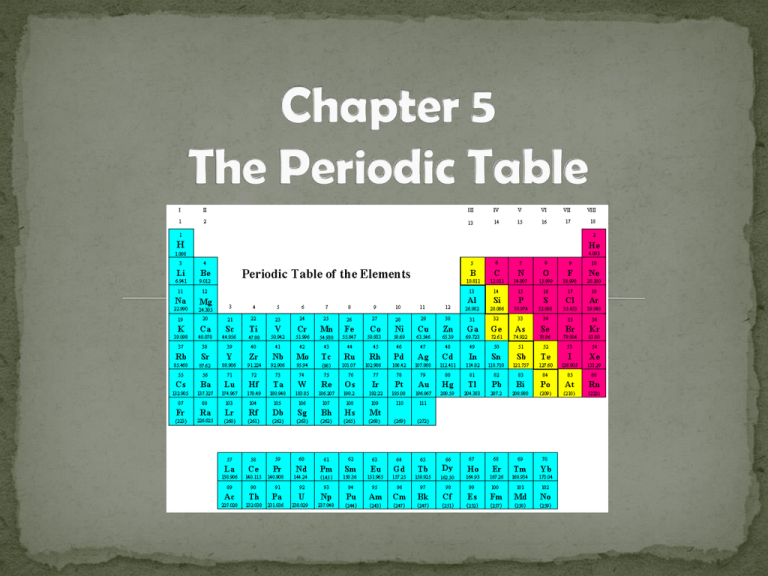
Key Concepts: Mendeleev arranged the elements into rows in order of increasing mass so that elements with similar properties were in the same column. · The close match between Mendeleev’s predictions and the actual properties of new elements showed how useful his periodic table could be. The periodic table is the most useful tool in chemistry. You get to use it on quizzes and tests! It organizes lots of information about all the known elements. …was a mess!!! No organization of elements. Imagine going to a grocery store with no organization!! Difficult to find information. Chemistry didn’t make sense. Previous attempts to organize known elements failed to work for all known elements at the time Russian Chemist and teacher, Dmitri Mendeleev, discovered a way Found a way to approach the problem when playing his favorite card game, a version of solitaire (organization was the key) Solitaire…?????? HOW HIS WORKED… Put elements in rows by increasing atomic weight. Elements with similar properties were in the same column. Put elements in columns by the way they reacted. Periodic Table: an arrangement of elements in columns, based on a set of properties that repeat from row to row Table was not complete, not all elements had yet been discovered He left gaps/spaces in his table for those elements He was NOT the first to organize the elements in the form of a table He was the FIRST to offer good explanations for how the properties of an element were related to its location in his table He used the gaps in his tables to predict properties of undiscovered elements Other scientists used the predictions to help in their search for undiscovered elements The close match between Mendeleev’s predictions and the actual properties of new elements showed how useful his periodic table could be With the periodic table, chemists could do more than predict the properties of new elements – they could explain the chemical behavior of different groups of elements!!! Mendeleev wasn’t too far off. Now the elements are put in rows by increasing ATOMIC NUMBER!! The horizontal rows are called periods and are labeled from 1 to 7. The vertical columns are called groups are labeled from 1 to 18. Period: A row in a periodic table of elements (left to right) To understand the structure of the table, think what happens as the atomic number increases: Reminder: Atomic Number = Number of Protons First energy level has ONLY 1 orbital The 1 e- in a hydrogen atom and 2 e- in a helium atom can fit in this orbital (first energy level) This is why H and He are in Period 1 Lithium, 1st element in Period 2, has one of its the three electrons in the second energy level This is why lithium is the first element in Period 2 Sodium, 1st element in Period 3, has one e- in its third energy level Potassium, 1st element in Period 4, has 1 e- in its fourth energy level This pattern applies to ALL the elements in the 1st column on the table Columns are also grouped into families (or groups). Families may be one column, or several columns put together. Families have names (Just like your family has a common last name.) Group: A column in a periodic table of elements Properties of elements repeat in a predictable way when atomic numbers are used to arrange elements into groups Periodic Law: the pattern of repeating properties displayed by elements in the periodic table Elements within a group have similar properties: Similar e- configurations (see example above – first column of the table) Electron configuration determines an elements chemical properties Atomic mass is a value that depends on the distribution of an element’s isotopes in nature and the masses of those isotopes. Mass of an atom in grams is EXTREMELY small Scientists came up with an easier way to talk about mass Chose one isotope to serve as a standard Scientists assigned 12 atomic mass units (amu’s) to the carbon-12 atom (which has 6P and 6N) Atomic Mass Unit (amu): 1/12 the mass of a carbon-12 atom Chlorine has an atomic number of 17 and an atomic mass of 35.453 atomic mass units Where does the number 35.453 come from??? There are two natural isotopes of Chlorine: Chlorine-35 which has 17 protons and 18 neutrons Chlorine-37 which has 17 protons and 20 neutrons Atomic masses come from an average of the isotopes for a given element that exist in nature The value for atomic mass is known as a “weighted average” Cl-35 occurs 3 times as often as Cl-37 Take an average of those numbers: (3 × 35) + (1 × 37) ----------------------------4 = 35.453 Elements are classified as metals, nonmetals, and metalloids. Metals: elements that are good conductors of electric current and heat. Properties of Metals: Except for mercury, metals are solid at room temperature Most metals are malleable Many metals are ductile (can be drawn into thin wires) Some metals are extremely reactive* (page 135, figure 10) *Meaning they easily combine chemically with other elements Transition Metals: metals in groups 3-12, form a bridge between the elements on the left and right sides of the tables. Examples: copper and silver Some of the first elements discovered Ability to form compounds with distinctive colors (page 137 production of colored glass) Includes the lanthanide and actinide series (at the bottom of the table) Nonmetals: elements that are poor conductors of heat and electric current Properties opposite those of metals Low boiling points Most are gases at room temperature Nonmetals that are solid at room temperature tend to be brittle (will shatter) Some very reactive, some not at all, some fall somewhere in between Fluorine (in Group 17) is the most reactive nonmetal (found in toothpaste) Metalloids: elements with properties that fall between those of metals and nonmetals Ability to conduct electric current varies with temperature Pure silicon (Si) and germanium (Ge) are good insulators at low temperatures and good conductors at high temps. Across a period from left to right, the elements become less metallic and more nonmetallic in their properties Most reactive metals on left side Most reactive nonmetals on the right side (in Group 17) Period 3 elements (left to right) provide an example of this (page 138, Figure 13) Why is hydrogen (H) on the left side of the table with the active metals? Hydrogen’s location is related to its electron configuration, not its properties!!! Wonder why there are 2 numbering schemes on the periodic table? When the ‘A’ groups are numbered 1-8, they provide a reminder about the electron configurations of the elements in those groups The number of an ‘A’ group matches the number of valance electrons in an electron configuration for an element in that group Valence Electron: an electron that is in the highest occupied energy level of an atom Valence electrons play a key role in chemical reactions Properties vary across a period because the number of valence electrons increases from left to right Elements in a group have similar properties because they have the same number of valence electron Hydrogen is on far left of table because it has one valence electron, just like the rest of the elements in that column Hydrogen belongs to a family of its own. Hydrogen is a diatomic, reactive gas. Hydrogen was involved in the explosion of the Hindenberg. http://www.youtube.co m/watch?v=F54rqDh2m WA Hydrogen is promising as an alternative fuel source for automobiles. 1st column on the periodic table (Group 1 /1A) not including hydrogen. Very reactive metals, always combined with something else in nature (like in salt). Single valence electron Soft enough to cut with a butter knife. The reactivity of alkali metals increases from the top of Group 1A to the bottom Lithium (Li) down through Francium (Fr) http://www.youtube.com/watch?v=m55kgyApYrY Group 2 / 2A on the periodic table. Reactive metals that are always combined with nonmetals in nature. Several of these elements are important mineral nutrients (such as Mg and Ca). 2 valence electrons Harder than metals in Group 1A Higher melting point than Group 1A Differences in reactivity among the alkaline earth metals are shown by the ways they react with water Calcium, strontium, and barium react easily with cold water Magnesium reacts with hot water No change with beryllium and water Elements in groups 3-12 Less reactive, harder metals. Includes metals used in jewelry and construction. Most are hard and shiny. Elements in group 13 (3A) Aluminum: Metal was once rare and expensive, not a “disposable metal.” Most abundant metal in Earth’s crust Less reactive than sodium and magnesium strong, lightweight, malleable, and good conductor of electric current 3 valence electrons Boron is used in glassware like flasks because it doesn’t shatter when it undergoes a rapid temperature change Elements in group 14 (4A) Group 4A contains one nonmetal (C), 2 metalloids (Si, Ge), and 2 metals (Sn, Pb) Contains elements important to life and computers. Carbon is the basis for an entire branch of chemistry. Coal and oil are mostly made of carbon. 4 valence electrons Metallic nature increases from top to bottom (Ge is better conductor than Si) Life would not exist without carbon (except for water, most of the compounds in your body contain carbon) Reactions in your body controlled by carbon compounds Si is 2nd most abundant element in Earth’s crust (found in rocks, sand, and glass) Elements in group 15 (5A) Nitrogen makes up over ¾ of the atmosphere. Nitrogen and phosphorus are both important in living things. The red stuff on the tip of matches is phosphorus. 5 valence electrons 2 nonmetals, 2 metalloids, and 1 metal Contain a wide range of physical properties Elements in group 16 (6A) Oxygen is necessary for respiration. Many things that stink, contain sulfur (rotten eggs, garlic, skunks, etc.) 6 valence electrons 3 nonmetals and 2 metalloids Oxygen is most abundant element in Earth’s crust The 10 most abundant elements by mass in the earth's crust . All are main-group elements except iron and titanium. Elements in group 17 (7A) Very reactive, volatile, diatomic, nonmetals Always found combined with other element in nature . Used as disinfectants and to strengthen teeth. 7 valence electrons Despite physical differences, the halogens have similar chemical properties Highly reactive nonmetals, with fluorine being the most reactive and chlorine a close 2nd React easily with most metals Chlorine added to drinking water and swimming pools to kill bacteria Elements in group 18 (8A) VERY unreactive, monatomic gases Used in blimps to fix the Hindenberg problem. Have a full valence shell. 8 valence electrons EXCEPTION is Helium, it has 2 valence electrons Colorless and odorless Used in lighted “neon” signs

